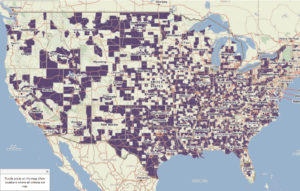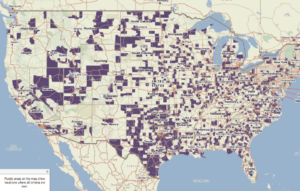Advanced Practice Nurse Data

Data
Advanced Practice Registered Nurses
Source
HRSA
Find on PolicyMap
- Health
- Health Professionals
- Advanced Practice Nurses
- Health Professionals
Nurse shortages in the United States are showing no sign of abating as existing nurses reach the age of retirement, nursing schools remain insufficient to meet demand, an aging population requires more intensive health support, and a growing focus on preventative care encourages frequent healthcare visits. As is often the case, some areas are hit harder than others. To get a sense of where the problem is most acute, we can look at nursing data.
PolicyMap has expanded our data on health care professionals to include Advanced Practice Registered Nurses (APRN), to help provide insight into which counties have better access to nurse care.
Advanced practice nurses are registered nurses that have additional education, training, and certification in a nursing specialty, or meet other equivalent requirements as approved by the Board of Nursing. APRNs typically “coordinate patient care and may provide primary and specialty healthcare,” according to the Bureau of Labor Statistics. The APRN designation includes advanced practice midwives, certified registered nurse anesthetists, clinical nurse specialists, and nurse practitioners.
PolicyMap now shows the rate (per 1,000 people) and number of APRNs, nurse practitioners, and advanced practice midwives from 2010 to 2016. This data comes from the Health Resources and Services Administration (HRSA), but was originally collected by the Centers for Medicare and Medicaid Services (CMS) National Provider Identification File.
Nurse Practitioners
Nurse practitioners have graduate degrees in nursing and usually provide primary care, though they may also specialize, such as becoming a family nurse practitioner, gerontological nurse practitioner, pediatric nurse practitioner, obstetric-gynecologic nurse practitioner, or school nurse practitioner. In some states, nurse practitioners have been approved with “full practice” status, allowing them to assess, order tests, diagnose, and prescribe medications without the supervision of a physical, which enables them to work more independently than other registered nurses and carry out all stages of treatment with a patient.

In areas with a shortage of primary care physicians, nurse practitioners can help alleviate the problem. Currently a significant number of counties in the U.S. have less than 0.5 primary care physicians per 1,000 residents.

However, significantly fewer counties have less than 0.5 primary care physicians AND less than 0.5 nurse practitioners per 1,000 residents. The difference is particularly visible in the south. It is especially important that areas with physician shortages have access to nurse practitioners, as several studies demonstrate that nurse practitioners provide comparable care as primary care doctors but at a lower cost, which is vital in rural underserved areas.
Advanced Practice Midwives
Advanced practice midwives are comprised of certified nurse-midwives (CNMs) and certified midwives (CMs). Both CNMs and CMs must pass the national certification examination and graduate from an ACME-certified nurse-midwifery education program, however, CMs have an additional background in another health related field outside of nursing. Midwifery practice includes “the independent management of women’s health care, focusing particularly on pregnancy, childbirth, the post-partum period, care of the newborn, and the family planning and gynecologic needs of women”, according to the HRSA. Both CNMS and CMs comply with practice standards as established by the American College of Nurse-Midwives.
As might be expected, counties in the US with higher rates of live childbirths are associated with higher numbers of advanced practice midwives (comparing the two maps below):
When exploring this new APRN data, it might be useful to remember that PolicyMap offers additional data from HRSA that might be helpful in your analysis, including medically underserved areas (MUA), primary care doctors, dentists, emergency room visits, and additional information on health facilities, all available in the Health Menu under “Access to Medical Care.”